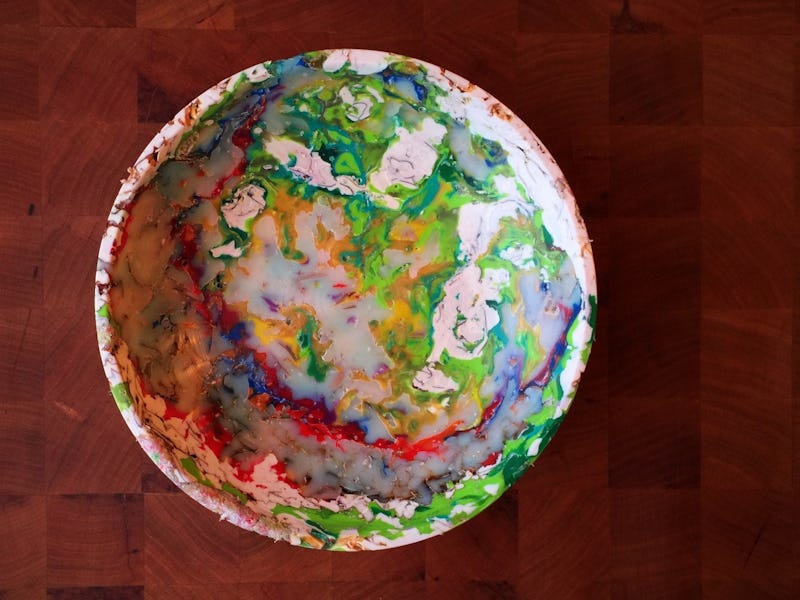How to Sculpt High-Density Polyethylene and Make Soda Caps Into Weird AF Bowls
Shawn Mergler teaches us how to make a bowl out of Mountain Dew tops.

Shawn Mergler is a furniture design student in Buffalo, NY who sees creative possibility in plastic bottle caps and milk jugs. He wants plastic to be more than trash, but it’s hard to bend high-density polyethylene to one’s will. The two tricks, Mergler discovered, are heat and patience. The process of re-molding plastic doesn’t, he says, have to be particularly complicated.
“Using plastic is not only resourceful, since it would normally end up in the garbage, but it also provides you a lot of different opportunities.” Mergler says, adding that he was inspired to leave wood, his typical medium, behind by some internet videos. He decided to take tchotchke creation to the next level.
Here’s the first hard truth of artisanal plastic-bowl making: collecting the plastic takes up the most time. It took Mergler four months to pick the necessary plastic out of his garbage — he didn’t want to buy foods simply for containers. His main source of HDPE? Mountain Dew bottle caps, which he knew wouldn’t emit poisonous fumes when burned (the symbol for HDPE is a 2 inside a recycling triangle). It was not lost on Mergler that this was the same kind of plastic Walter White and Jesse use in Breaking Bad to dissolve a body in hydrofluoric acid.
Mergler's HDPE plastic collected over a few months
Once he’de collected enough plastic, you can follow Mergler’s route of cutting it up into tiny bits, an arduous process that he approximates took up six or seven hours. Looking back, he says the bottle caps and milk jugs melted more easily than he expected, so cutting them up may not be totally necessary. He initially cut the plastic and separated it by color because he wanted to add intentional striation to the bowl, but that got messed up a bit later when he ran into a chemistry hiccup. We’ll get to that in a bit, though.
The cut up bits of HDPE plastic
Time to melt plastic. Mergler filled up a glass bowl with the cut up plastic, creating a purposefully layered design with the different colors he had on hand. He initially put it on the grill outside to avoid any dangerous fumes just in case some other kinds of plastic had gotten mixed in with his HDPE amalgam. As the plastic begins to melt at about 425 degrees Fahrenheit, you’ll have to continue adding plastic into the bowl. It started to get dark outside, so Mergler moved his glass bowl from the grill onto a cooking sheet to put into the oven, but this is where he ran into a science hiccup: glass doesn’t like rapid changes in temperature, so the dish cracked when he transferred it to the baking sheet. He then had to scoop the goopy mixture out and transfer it into another bowl, which is what jumbled his carefully-planned color scheme. The lesson: Don’t transfer melting bowls!
This is where Mergler’s plan becomes singular to him. After your have your slab of melted plastic, or your blank, you can start shaping it into whatever you want. Since Mergler is an experienced furniture designer, he has a lathe at home that he used to turn the outside shape of the bowl and then hollow out the inside. “I was nervous about putting it on the lathe, but it cuts even more smoothly than wood,” he said.
Don’t worry if you don’t have a fancy lathe or other woodworking tools: There’s a way around that in the melting process.
“You would be able to melt it in a bowl just like I did, but put another bowl on the inside and melt it between the two bowls,” explain Mergler. That would take care of your bowl shape, and then you could just use some sandpaper or a razor blade to smooth out the jagged edges around the top. Voila! You have your very own bowl made out of melted plastic bottle caps.
Going forward, Mergler has plans to merge his furniture making skills with his DIY plastic melding. “I’d like to translate it into furniture, so instead of making a bowl, I could make the equivalent of a board, and then treating it like wood, I could make a table or a chair or a cabinet.” He would of course need a steady supply of HDPE plastic for consistent projects in the future, but Reddit users have already offered to ship him materials. As for you guys who are looking to begin your plastic melting journey with something more basic, you should start collecting that HDPE plastic.
Aerial view of the bowl